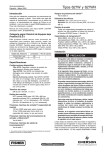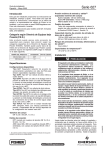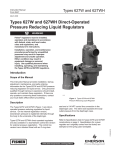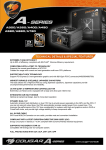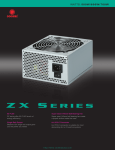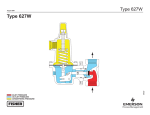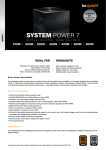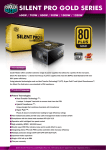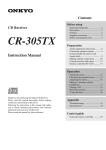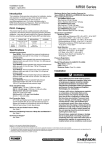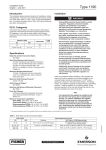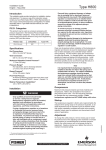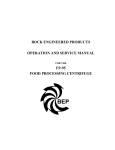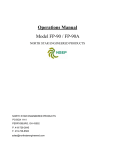Download Emerson 627W Installation Guide
Transcript
Installation Guide English – May 2002 Types 627W and 627WH Proof Test Pressure This installation guide provides instructions for installation, startup, and adjustment. To receive a copy of the instruction manual, contact your local Fisher Sales Office or Sales Representative or view a copy at www.FISHERregulators.com. For further information refer to: Types 672W and 627WH Instruction Manual (form 5447, D102504X012). P.E.D. Category This product may be used as a safety accessory with pressure equipment in the following Pressure Equipment Directive 97/23/EC categories. It may also be used outside of the Pressure Equipment Directive using sound engineering practice (SEP) per table below. PRODUCT SIZE CATEGORIES DN 20-25 (3/4-1-inch) sizes only SEP DN 50 (2-inch) I, II Specifications Available Constructions Type 627W: Direct operated pressure reducing liquid regulator. Type 627WH: Type 627W with a diaphragm limiter to deliver a higher outlet pressure. Control Line Option: Type 627W or Type 627WH with a stem seal between the body outlet pressure and diaphragm case. Pressure is measured under the diaphragm through the 6,4 mm (1/4-inch) NPT screwed downstream control line connection. Body Sizes DN 20, 25, or 50 (3/4, 1, or 2-inch) End Connection Styles NPT Screwed; ANSI Class 150, 300, and 600 RF flanged [DN 25 or 50 (1 and 2-inch sizes) only]; or PN 16/25/40 [DN 25 or 50 (1 and 2-inch sizes) only] Maximum Inlet Pressures(1) (body rating) 140 bar (2000 psig) for screwed steel 70 bar (1000 psig) for ductile or body rating, whichever is lower Maximum Operating Inlet and Differential Pressures(1) See table 1 Maximum Operating Outlet Pressures(1) See table 1 Outlet Pressure Ranges(1) See table 2 Orifice Diameters Standard: 6,4 or 12,7 mm (1/4 or 1/2-inch) Optional: 2,4; 3,2; 4,8; or 9,5 mm (3/32, 1/8, 3/16, or 3/8-inch) All Pressure Retaining Components have been proof tested per Directive 97/23/EC - Annex 1, Section 7.4 Temperature Capabilities(1) Nitrile (NBR): -40 to 82°C (-40 to 180°F) Fluoroelastomer (FKM): -18 to 149°C (0 to 300°F) Ethylenepropylene (EPDM): -40 to 149°C (-40 to 300°F) Perfluoroelastomer (FFKM): -18 to 149°C (0 to 300°F) Nylon (PA): -40 to 93°C (-40 to 200°F) Teflon (PTFE): -40 to 149°C (-40 to 300°F) Installation Only qualified personnel should install or service a regulator. Regulators should be installed, operated, and maintained in accordance with international and applicable codes and regulations, and Fisher instructions. If the regulator vents fluid or a leak develops in the system, it indicates that service is required. Failure to take the regulator out of service immediately may create a hazardous condition. Personal injury, equipment damage, or leakage due to escaping fluid or bursting of pressurecontaining parts may result if this regulator is overpressured or is installed where service conditions could exceed the limits given in the Specifications section, or where conditions exceed any ratings of the adjacent piping or piping connections. To avoid such injury or damage, provide pressurerelieving or pressure-limiting devices (as required by the appropriate code, regulation, or standard) to prevent service conditions from exceeding limits. Additionally, physical damage to the regulator could result in personal injury and property damage due to escaping fluid. To avoid such injury and damage, install the regulator in a safe location. Clean out all pipelines before installation of the regulator and check to be sure the regulator has not been damaged or has collected foreign material during shipping. For NPT bodies, apply pipe compound to the male pipe threads. For flanged bodies, use suitable line gaskets and approved piping and bolting practices. Install the regulator in any position desired, unless otherwise specified, but be sure flow through the body is in the direction indicated by the arrow on the body. 1. The pressure/temperature limits in this installation guide and any applicable standard or code limitation should not be exceeded. www.FISHERregulators.com D102504XENG Introduction Types 627W and 627WH Note Startup It is important that the regulator be installed so that the vent hole in the spring case is unobstructed at all times. For outdoor installations, the regulator should be located away from vehicular traffic and positioned so that water, ice, and other foreign materials cannot enter the spring case through the vent. Avoid placing the regulator beneath eaves or downspouts, and be sure it is above the probable snow level. Overpressure Protection The recommended pressure limitations are stamped on the regulator nameplate. Some type of overpressure protection is needed if the actual inlet pressure exceeds the maximum operating outlet pressure rating. Overpressure protection should also be provided if the regulator inlet pressure is greater than the safe working pressure of the downstream equipment. Regulator operation below the maximum pressure limitations does not preclude the possibility of damage from external sources or debris in the line. The regulator should be inspected for damage after any overpressure condition. The regulator is factory set at approximately the midpoint of the spring range or the pressure requested, so an initial adjustment may be required to give the desired results. With proper installation completed and relief valves properly adjusted, slowly open the upstream and downstream shutoff valves. Adjustment To change the outlet pressure, remove the closing cap or loosen the locknut and turn the adjusting screw clockwise to increase outlet pressure or counterclockwise to decrease pressure. Monitor the outlet pressure with a test gauge during the adjustment. Replace the closing cap or tighten the locknut to maintain the desired setting. Taking Out of Service (Shutdown) To avoid personal injury resulting from sudden release of pressure, isolate the regulator from all pressure before attempting disassembly. Table 1. Maximum Spring and Diaphragm Casing Pressure(1) SPRING AND DIAPHRAGM CASING STYLE TYPE 627W bar (psig) TYPE 627WH psig (bar) Maximum pressure to spring and diaphragm casings to prevent leak to atmosphere (internal parts damage may occur) Ductile Iron 17,2 (250) --- --- Steel or Stainless Steel 17,2 (250) 55,2 (800) Maximum pressure to spring and diaphragm casings to prevent burst of casings during abnormal operation (leak to atmosphere and internal parts damage may occur) Ductile Iron 32,1 (465) --- --- Steel or Stainless Steel 103 (1500) 103 (1500) Maximum diaphragm casing overpressure (above setpoint) to prevent damage to internal parts. All Styles 4,1 (60) 8,3 (120) 1. If the spring case is pressurized, a metal adjusting screw cap is required. Table 2. Maximum Inlet Pressure, Differential Pressure, and Outlet Pressure Ranges TYPE OUTLET PRESSURE RANGE, SPRING PART NO., AND COLOR, BAR (psig) 0,69 to 1,4 (10 to 20) 10B 3076X 012 yellow 1,0 to 2,8 (15 to 40) 10B 3077X 012 green ORIFICE DIAMETER MAXIMUM INLET PRESSURE BAR (psig) MAXIMUM DIFFERENTIAL PRESSURE BAR (psig) elastomer disk nylon disk elastomer disk nylon disk 6,4 (1/4) 15,2 (220) 29,0 (420) 13,8 (200) 27,6 (400) 12,7 (1/2) 15,2 (220) 17,2 (250) 13,8 (200) 17,2 (250) 6,4 (1/4) 16,6 (240) 30,3 (440) 13,8 (200) 27,6 (400) 12,7 (1/2) 16,6 (240) 20,7 (300) 13,8 (200) 20,7 (300) 6,4 (1/4) 19,3 (280) 33,1 (480) 13,8 (200) 27,6 (400) 12,7 (1/2) 19,3 (280) 33,1 (480) 13,8 (200) 27,6 (400) 627W 2,4 to 5,5 (35 to 80) 10B 3079X 012 blue 4,8 to 10,3 (70 to 150) 10B 3078X 012 red 6,4 (1/4) 24,1 (350) 37,9 (550) 13,8 (200) 27,6 (400) 12,7 (1/2) 24,1 (350) 37,9 (550) 13,8 (200) 27,6 (400) 9,7 to 17,2 (140 to 250) 10B 3078X 012 blue 6,4 (1/4) 31,0 (450) 44,8 (650) 13,8 (200) 27,6 (400) 12,7 (1/2) 31,0 (450) 34,5 (500) 13,8 (200) 17,2 (250) 6,4 (1/4) 48,3 (700) 62,1 (900) 13,8 (200) 27,6 (400) 12,7 (1/2) 48,3 (700) 51,7 (750) 13,8 (200) 17,2 (250) 627WH 16,6 to 34,5 (240 to 500) 10B 3079X 012 red 2 Types 627W and 627WH Parts List Key Description Key Description 1 2 3 8 9 10 11 12 13 14 15 16 17 18 19 23 24 29 Spring Case 30 Vent 31 Lower Spring Seat (627W only) 32 Spring 33 Upper Spring Seat 34 Locknut 35 Adjusting Screw 36 Adjusting Screw Cap 37 Cap Screw 44 O-Ring 45 Backup Ring 46 Cap Screw 50 Diaphragm Limiter (627WH only) 51 O-Ring 52 O-Ring Body Orifice Diaphragm Casing Stem Guide Valve Plug Assembly Stem Stem O-Ring Stem Backup Ring Hair Pin Clip Drive Pin Lever Lever Retainer Lever Pin Cap Screw Pusher Post Assembly Diaphragm Diaphragm Head 34B7395 37B9752 Figure 1. Type 627W Regulator Components Figure 2. Type 627WH Regulator Components 3 Types 627W and 627WH ©Fisher Controls International, Inc., 2002; All Rights Reserved Fisher and Fisher Regulators are marks owned by Fisher Controls International, Inc. The Emerson logo is a trade mark and service mark of Emerson Electric Co. All other marks are the property of their respective owners. The contents of this publication are presented for informational purposes only, and while every effort has been made to ensure their accuracy, they are not to be construed as warranties or guarantees, express or implied, regarding the products or services described herein or their use or applicability. We reserve the right to modify or improve the designs or specifications of such products at any time without notice. For information, contact Fisher Controls, International: Within USA (800) 588-5853 – Outside USA (972) 542-0132 France – (33) 23-733-4700 Singapore – (65) 770-8320 Mexico – (52) 57-28-0888 Printed in U.S.A. www.FISHERregulators.com




